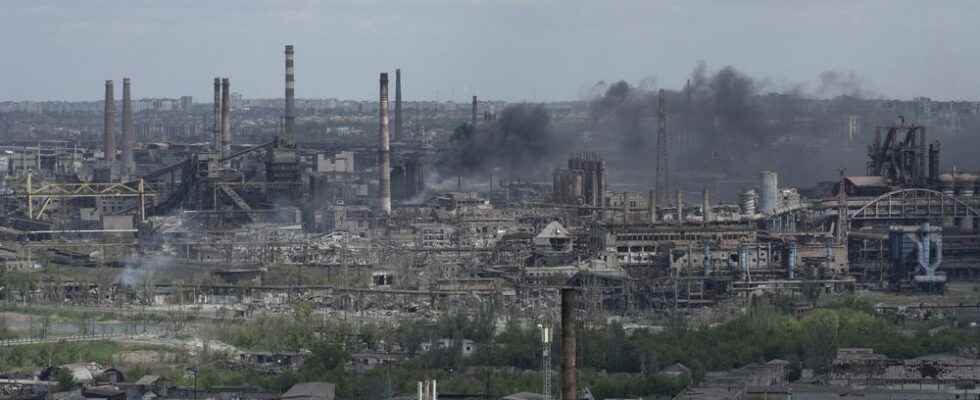After the failure of its initial offensive, can Russia fail to take Donbass? This nightmare scenario for Putin has come back to the fore in recent days in the face of the difficulties faced by Russian forces on the ground. On May 15, the Secretary General of NATO, Jens Stoltenberg, made himself crystal clear. “Its major offensive in Donbass has stalled, Russia is not achieving its strategic goals,” he said, adding that kyiv “can win” the war.
More than a month after announcing “to concentrate the bulk of efforts” on this region of eastern Ukraine, Moscow is struggling to show real military successes. Worse, in the Kharkiv region, Ukrainian forces managed to repel Russian troops and retake part of the border with Russia, kyiv announced on Sunday. A week earlier, the Russian attempt to cross the Donets River in the Bilohorivka area had also turned into a fiasco, ending with the destruction of a hundred vehicles, targeted by Ukrainian artillery. Should we therefore see the beginning of a Russian defeat in eastern Ukraine?
Step by step progress
“The Russian forces seem to be in great difficulty to conquer the whole region, but we must remain very careful, tempers General Dominique Trinquand, military expert and former head of the French mission to the UN. Because even if they advance slowly, that doesn’t mean they’re not moving forward.” Signs in this direction have also begun to emerge.
The Russian Ministry of Defense thus indicated on Wednesday that 959 Ukrainian soldiers entrenched in the Azovstal factory in Mariupol had surrendered since Monday. If we do not know the precise number of fighters who remain on site, Ukraine said last week that more than 1,000 soldiers, including 600 wounded, were still present in the huge steel complex. The final fall of Mariupol, after 84 days of fierce Ukrainian resistance, would constitute an important victory for Moscow, allowing it to have control of the entire coastal strip linking Crimea to the separatist territories of Donbass.
A view of the Azovstal factory in Mariupol, besieged by the Russian army
AFP
At the same time, the governor of Luhansk oblast, Serguiï Gaïdaï, indicated on Wednesday that the Russian forces were trying to break through near Popasna and in the direction of Severodonetsk. The day before, Ukrainian Defense Minister Oleksiï Reznikov had declared that the Russian army was trying “to encircle and destroy the consolidation of the Ukrainian armed forces in the regions of Donetsk and Lugansk”. Maneuvers which, if successful, could quickly destabilize the Ukrainian defense. “If the Russians managed to break through the front line, the Ukrainians could find themselves in less well-fortified areas and therefore more difficult to defend”, points out General Trinquand.
The obstacle of cities
It remains to be seen whether Moscow can still support the war effort in the long term. In a report published on Sunday, the British Ministry of Defense estimated that the Russian army had probably lost “a third” of its forces engaged since February 24. “Russian forces are increasingly constrained by degraded operational capabilities, persistently low morale and reduced combat effectiveness (…) under current conditions, Russia is unlikely to dramatically increase its pace of progress over the next 30 days”, details the document.
In addition, to achieve its objectives, Russia will have to manage to take the three main urban centers still in the hands of the Ukrainians in the area. “The capture of the Donbass involves seizing the cities of Severodonetsk (101,000 inhabitants), Sloviansk (106,000 inhabitants) and Kramatorsk (150,000 inhabitants), underlines Michel Goya, former colonel of the navy troops, today a historian of war. The operation would be difficult to say the least and would each time involve a siege comparable to that of Mariupol.” In short, a long and costly assault both in material and in human lives.
The massive arrival of Western heavy weapons could also complicate the deal for Russian troops worn out by nearly three months of fighting. “At the current rate, they can hope to encircle Severodonetsk at the beginning of June, believes Michel Goya. Then, it will certainly be necessary to take a break to reconstitute the forces before possibly attacking again this summer.” On Tuesday, the Ukrainian Defense Minister stressed that “the war is entering a protracted phase”, adding that Russian troops are currently fortifying their positions in the Zaporizhia and Kherson regions, in order to “go into defensive mode if necessary”. The conflict is set to last.
